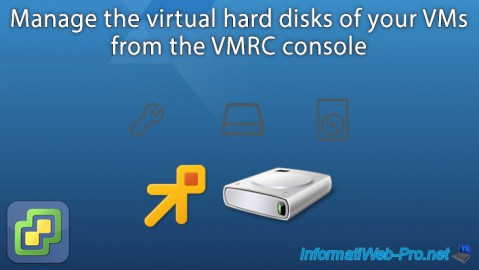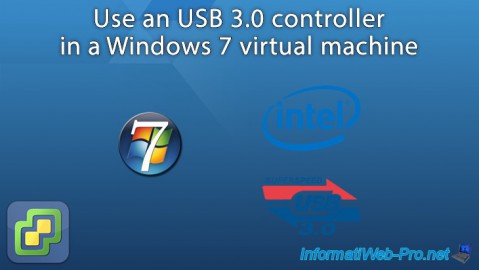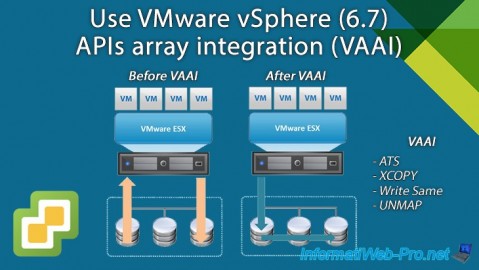Create a virtual machine with Windows as a guest OS on VMware vSphere 6.7
- VMware
- VMware vCenter Server (VCSA), VMware vSphere
- 27 March 2024 at 14:57 UTC
-

- 2/2
4. Start your Windows virtual machine
To begin, start your Windows virtual machine by clicking on the green triangle.

Next, open the console of your new virtual machine by clicking on the 3rd icon.
Note: you can also use the "Launch Web Console" and "Launch Remote Console" links located below the console preview of your virtual machine.

Choose if you want to use:
- the web console: which allows you to control your virtual machine from any modern web browser.
- VMware Remote Console (VMRC): which allows you to control your virtual machine from the free program “VMware Remote Console (VMRC)” which must be installed beforehand.
The main advantage of this method is that it allows you to benefit from a better user experience.
In our case, we used the VMware Remote Console (VMRC).

The console of your virtual machine appears.
Note: the appearance of the logo is not the same depending on the use of a virtual BIOS based on PhoenixBIOS or UEFI firmware.

Press any key to boot to your Windows installation DVD if this message appears in your case.

The Windows logo appears.

The Windows installer appears.

Install Windows as you would on a normal computer.

Wait while Windows installs.

5. Install VMware Tools on Windows
Once Windows is installed as the operating system, you need to install the VMware Tools to improve your user experience with this virtual machine and install the various necessary drivers provided by VMware.
To do this, click: VMRC -> Manage -> Install VMware Tools.

If you have not used this "VMware Remote Console (VMRC)" program, you can click on the "Install VMware Tools" link available to the right of the warning displayed by VMware vCenter Server (VCSA) indicating that VMware Tools does not is not installed on this virtual machine.

Last possibility: open the “Actions” menu and click: Guest OS -> Install VMware Tools.

In any case, a virtual CD named "VMware Tools" will appear in the guest operating system that you installed in your virtual machine.
To start the installation of these VMware Tools on Windows (or Windows Server), double-click on the “VMware Tools” CD/DVD drive.

If Windows autorun is disabled in your case, launch the file corresponding to the Windows architecture you have installed:
- setup.exe: for the 32-bit (x86) version of Windows (or Windows Server)
- setup64.exe: for the 64-bit (x64) version of Windows (or Windows Server)

The VMware Tools installation wizard appears.
Just click Next.

Most of the time, a typical VMware Tools installation will suffice.
This choice is the default and is sufficient if your virtual machine is only used with a VMware product.
In case you want to be able to use this virtual machine with different VMware products, prefer a complete installation of VMware Tools.

Wait while the VMware Tools and various drivers provided by VMware install.

After completing the VMware Tools installation wizard, click: Finish.
Then restart the virtual machine as prompted by this installation wizard.

Once the virtual machine has restarted, you will see that a "VM" icon has appeared in the taskbar next to the time.
![]()
If you look in your virtual machine information, you will see that the VMware Tools are installed.
Indeed, VMware vCenter Server (VCSA) tells you that:
- VMware Tools are running
- the version of these
- the version installed in the operating system corresponds to the latest version available in your case.

6. Files making up the Windows virtual machine
If you go to the datastore where you just created your Windows virtual machine, you will see that it is made up of different files.
In particular, a configuration file (in .vmx) and a virtual hard disk (in .vmdk).
For more information regarding the composition of VMware virtual machines, refer to the page: Files of VMware virtual machine.

Share this tutorial
To see also
-

VMware 12/9/2022
VMware ESXi 6.7 - Manage the virtual hard disks of your VMs from the VMRC console
-

VMware 2/3/2023
VMware ESXi 6.7 - Use an USB 3.0/3.1 controller with Win 7
-

VMware 9/27/2024
VMware vSphere 6.7 - Array integration APIs (VAAI)
-

VMware 5/17/2024
VMware vSphere 6.7 - Create and manage tags

No comment